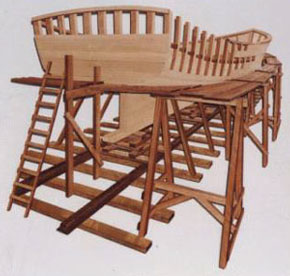
When you first look into one of Luis Costa’s ship murals, you have to remind yourself it’s really only a two-dimensional work in wood. So closely has the Portuguese craftsman captured the depth and detail from stern to bow in works such as “Estaleiro” that you’d swear you could walk around to the other side. That perception of depth, according to Luis, is all based on his original drawings.
“If the drawing is OK, the work is OK,” explained Luis. “If the drawing is no good, the work is no good. I spend a lot of time doing good drawings so that I can be sure when it comes to the wood, it’s good work.”
Working out of a small studio near his house in Portugal, Luis has developed a rapt following of collectors eager for his latest work. Having only started to cut and carve wood three or four years, ago, to call him an instant sensation would not be far from the truth. After working as a company manager for many years, Luis decided he wanted to do something different – to work in wood and create nautical images.
“My father was a sailor,” recalled Luis, “and since I was a young boy I loved boats, especially the old wooden boats.”
So after some experimentation he came up with his approach of meticulous drawings, careful selection of wood, and subtle differences in wood thickness. At first he sold his murals through galleries, then word spread and clients started coming directly to him, buying whatever he had finished. Hotels, wanting a dramatic mural for their lobbies, have become some of his best customers.
What prepared him for this success? He first learned to work with wood with his father. And though he says he’s no historian, Luis has studied the history of ships, and he studied engineering and had some drawing classes in college. But the techniques he uses today, he describes as coming to him as he experimented and worked the wood. He described the steps involved in creating a finished piece.
“I might look at some books and pictures, and when I’m inspired by something I like, I do a small drawing of that particular shape or boat. The drawing must be correct with the right proportions. Then I enlarge the drawing and transfer it to the wood and cut it out – the band saw is my main tool. Of course there are many things that are not drawn – some of the third dimension is in the drawing and some is in the thickness of the wood. There are very thin pieces like the masts and thicker parts like the hulls. It depends on the work, but the maximum thickness is one inch.”
Working alone, he’s learned from experience what kinds of wood provide the right shade and color to his work. Leaving the wood natural, he only adds a little varnish to protect the surface.
Generally, Luis does not work to order & with a few exceptions.
“If they have an old boat,” he explained, “and would like it represented in my style of work & well, it might be possible, but usually I do not represent particular boats. Just the ones I like to do, and some historical boats.”
That doesn’t mean he doesn’t get orders; it just means his customers buy whatever Luis creates. And today, he makes a full-time living just doing the work he wants to do. In fact, when we talked with him he’d sold every piece he’d made and had no work on hand at the moment to show.
Did he know there would be a demand?
“I didn’t really know. I started with simple, small work, and they sold very quickly, and I understood that there would be a good demand and good appreciation for the work. So I started doing some more and, well, so far, so good.”
He made a couple of picture frames when he first started, but his ship murals are now the only woodworking he does. And though he enjoys the entire process (he calls it his relaxation), the best part of each project comes when Luis puts all the pieces together and he can look at it and say, “OK, it’s good. That’s it.”







